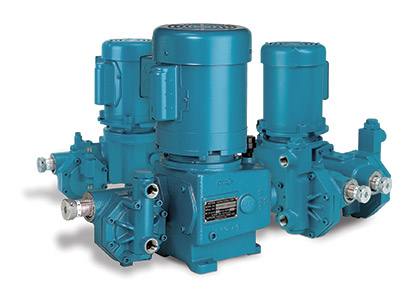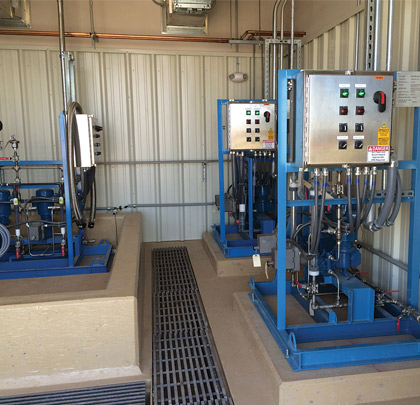A typical agriculture or process application can consume large amounts of chemicals during daily operations. While the volumes may be large, though, they must also be very precise, with exact amounts delivered according to strict injection schedules. The pressures—from very high to very low—that the chemicals are injected at must also be governed precisely. This demand for precise flow rates at predetermined schedules and pressures requires the use of a very specific pumping technology, one that can ensure successful, reliable adherence to the injection schedule and fluid volumes.
Metering pumps have—whether mechanically, hydraulically or electronically actuated—risen to the fore as a technology of first choice for the injection of chemicals in processing and agricultural applications. Today’s metering-pump technology can be easily set to deliver exact volumes according to a set schedule, and at varying pressures.
But within the realm of metering pumps there are many different styles and modes of operation. This article will explain the different metering-pump technologies and show how the user should select the proper size and style depending on the injection application for which the pump will be tasked.
KNOW THE VARIABLES
When determining which metering pump is the best option for a chemical-injection application there are a number of variables that must be taken into consideration, including the following.
Flow Rate
Metering pumps should never be oversized, meaning that determining the exact flow rate that is required for the application is of paramount importance. With that in mind, a metering pump should be sized so that the maximum expected flow rate is 85 to 90 percent of the pump’s capacity, which will leave room for additional capacity, if needed.
Materials of Construction
Metering pumps are available in a variety of materials, most commonly 316 stainless steel, C-20 stainless steel, PVC, and Kynar® PVDF. When selecting a metering pump’s materials of construction, the corrosion, erosion and solvent action of the chemical must be taken into consideration. For example, solvent-based chemicals may dissolve plastic-headed pumps, while acids and caustics may require stainless-steel models. The effects of erosion must also be considered when the chemical takes the form of an abrasive slurry.
Chemical Makeup
Chemicals come in many formulations, from extremely thin to highly viscous, while they can also be classified as a slurry or off-gas when transferred. Standard metering pumps are typically able to handle clear liquids with viscosities ranging from water-like to 1,500 cPs. Chemicals with viscosities that approach 5,000 cPs or have light suspensions will require special liquid ends. Those with viscosities up to 20,000 cPs or that contain up to 10 percent solids will require special diaphragms, while ones that automatically vent accumulated gas will need their own variety of liquid ends.
Driver
Drivers, which can be powered by electricity, water, gas, air, or the sun, must be selected according to the utilities that are available. Driver selection must also take into account any environmental hazards that may be found in the operating area, with the operator realizing that pumps used in remote locations may not be able to be inspected as often as those in controlled environments.
Environment
Determine if the pump will be operating indoors or outdoors. If used outdoors, the pump must be sheltered from direct sunlight. Any pumps that will be used in freezing temperatures can only pump fluids that will not freeze at that temperature.
Method of Control
The operator must know how the pump will be used, either manual continuous operation, on/off operation of operation that is governed by a process signal

NeptuneTM Metering Pumps from PSG®, a Dover company
THE IMPORTANCE OF METHOD OF CONTROL
When all is said and done, method of control may be the most important variable when choosing a metering pump, so let’s take a closer look. Many styles of metering pumps allow their flow rate to be adjusted manually through the use of a micrometer dial. Adjusting this dial changes the pump’s stroke length and allows the pump to be operated anywhere between 10 and 100 percent of its rated flow capacity. Metering pumps with micrometer dials may also feature a variable speed drive that allows adjustment of the pump’s stroke speed. Utilizing the two in unison can allow additional adjustability or turndown capabilities over the range of the drive, depending on the pump’s stroking speed. For example, a pump operating at 75 strokes per minute (spm) would produce a 5:1 turndown ratio on speed with the variable speed drive and a 10:1 turndown ratio on stroke length via the micrometer dial.
Flow rates can also be controlled automatically by a process signal and through the implementation of electric or pneumatic positioners that can adjust the stroke length, which will deliver a full 10:1 turndown ratio. In this method of control, the number of doses will remain constant with the size of each dose reduced, resulting in doses that are uniformly distributed in a constantly flowing line.
Metering pumps that use a variable speed drive will deliver a turndown ratio that is determined by dividing the pump’s stroke speed by its minimum operating speed. A variable speed drive will enable the pump to inject a dose of the same size on each stroke, but since the stroke speeds will change, the doses themselves will be less frequent. Additionally, it is not practical to use a variable speed drive on motor-driven pumps that normally operate at speeds less than 100 to 150 spm since slowing the motor causes each stroke to take longer to complete from start to finish. However, electronic metering pumps, which are pulsed by a solenoid, can operate at less than one spm because the timing of each stroke from start to finish is uniform at every stroking speed.
A LOOK AHEAD
Next month, the conclusion of this case study will illustrate the installation and refinement stage of the project. Now that all of the variables have been identified and reviewed, we’ll take a closer look at designing the pumping system, with a focus on potential location or environmental concerns.
ABOUT THE AUTHOR
Tom O’Donnell is director of business development for Neptune™ Chemical Pump Company and PSG®. He can be reached at 215.699.8700, ext. 3327 or tom.odonnell@psgdover.com. Neptune is a leading manufacturer of chemical metering and peristaltic (hose) pumps, chemical feed systems, chemical injection accessories, make-down systems and industrial mixers, plus steam and water sample analysis panels. Neptune is a product brand of PSG®, a Dover company. For more information, visit www.neptune1.com and www.psgdover.com.
____________________________________________
MODERN PUMPING TODAY, May 2016
Did you enjoy this article?
Subscribe to the FREE Digital Edition of Modern Pumping Today Magazine!



